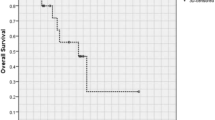Abstract
The classification of lower-grade gliomas has been greatly altered since the 2016 World Health Organization (WHO) introduced molecular diagnostics as part of their recommendations. Clinical trials that dictate treatment approaches, however, are based on histological classification. This chapter addresses the standard guidelines for contouring and planning for treatment of lower-grade gliomas, as well as clinical pearls for imaging.
Access provided by Autonomous University of Puebla. Download chapter PDF
Similar content being viewed by others
Keywords
14.1 General Principles of Simulation and Target Delineation (Table 14.1 and Fig. 14.1)
-
CT simulation with a thermoplastic mask for immobilization.
-
Obtain a volumetric thin slice MRI with T1 pre- and post-gadolinium, T2, and FLAIR for target delineation. The gross target volume (GTV) for low-grade glioma is the non-enhancing and enhancing mass which is best visualized on FLAIR sequences and T1 post-gadolinium sequences, respectively.
-
Ideally, fuse both the preoperative and postoperative T2/FLAIR and post-gadolinium MRIs to help delineate target volume; however, the postoperative MRI is what determines the volumes.
-
If the patient has contraindications to MRI, can use CT with and without contrast, but this is substandard.
-
In cases of partial or complete lobectomy, the region anterior to the resection edge where no brain tissue is present does not need to be included in the GTV.
-
CTV expansion should respect natural anatomic barriers, including the bone, tentorium, fax, and dura.
-
Tumors can cross the corpus callosum, which should be included in CTV expansion.
-
3D conformal, IMRT, or proton therapy can be considered to spare normal brain and hippocampi when possible.
14.2 Dose Prescriptions
-
50.4–60 Gy in 1.8–2.0 Gy fractions.
-
Grade II and/or IDH mutant glioma: 50.4–54 Gy.
-
Grade III and/or IDH wild-type glioma: 59.4–60 Gy; if there is no contrast enhancement, the PTV will be treated to the full dose; in some centers, if there is contrast enhancement, a cone down will occur after 50.4 Gy.
In the past, 50.4–54 Gy for grade II glioma and 59.4–60 Gy for grade III glioma. With the publication of the 2016 World Health Organization Classification of Tumors of the Central Nervous System, gliomas are now classified by IDH mutation rather than grade given it has better prognostic value. Though controversy in this area exists, many consider dose dependent on IDH mutation status rather than grade.
14.3 Treatment Planning Techniques
-
3D CRT, IMRT, VMAT, or proton therapy may be used with the goal of sparing the contralateral brain, hippocampi, cochleae, and pituitary if possible (Figs. 14.2 and 14.3).
-
Treatment planning aimed to cover 95% of the PTV volume by 95% of the prescribed dose for photon plans and 100% of the CTV volume by 100% of the prescribed dose for proton plans while respecting the OAR constraints. For complex tumors adjacent to critical OAR like the chiasm, brain stem, and optic nerves, coverage may suffer to 90% coverage of the PTV by 95% of the prescribed dose and plan acceptability taken on a case-by-case basis (Table 14.2).
14.4 Side Effects
See Table 14.3.
References
Batth SS, Sreeraman R, Dienes E, Beckett LA, Daly ME, Cui J, Mathai M, Purdy JA, Chen AM (2013) Clinical-dosimetric relationship between lacrimal gland dose and ocular toxicity after intensity-modulated radiotherapy for sinonasal tumours. Br J Radiol 86(1032):20130459
Further Reading
Baumert BG et al (2016) Temozolomide chemotherapy versus radiotherapy in high-risk low-grade glioma (EORTC 22033-26,033): a randomised, open-label, phase 3 intergroup study. Lancet Oncol 17(11):1521–1532
Buckner JC et al (2016) Radiation plus procarbazine, CCNU, and vincristine in low-grade glioma. N Engl J Med 374(14):1344–1355. PMID: 27050206
Cairncross G et al (2013) Phase III trial of chemoradiotherapy for anaplastic oligodendroglioma: long-term results of RTOG 9402. J Clin Oncol 31(3):337–343
Louis DN et al (2016) The 2016 World Health Organization classification of tumors of the central nervous system: a summary. Acta Neuropathol 131(6):803–820
van den Bent MJ et al (2013) Adjuvant procarbazine, lomustine, and vincristine chemotherapy in newly diagnosed anaplastic oligodendroglioma: long-term follow-up of EORTC brain tumor group study 26951. J Clin Oncol 31(3):344–350
van den Bent MJ et al (2017) Interim results from the CATNON trial (EORTC study 26053-22054) of treatment with concurrent and adjuvant temozolomide for 1p/19q non-co-deleted anaplastic glioma: a phase 3, randomised, open-label intergroup study. Lancet 390(10103):1645–1653
Author information
Authors and Affiliations
Corresponding author
Editor information
Editors and Affiliations
Rights and permissions
Copyright information
© 2021 Springer Nature Switzerland AG
About this chapter
Cite this chapter
Halasz, L.M., Sahgal, A., Chang, E.L., Lo, S.S. (2021). WHO Grades II and III Glioma. In: Halasz, L.M., Lo, S.S., Chang, E.L., Sahgal, A. (eds) Intracranial and Spinal Radiotherapy . Practical Guides in Radiation Oncology. Springer, Cham. https://doi.org/10.1007/978-3-030-64508-3_14
Download citation
DOI: https://doi.org/10.1007/978-3-030-64508-3_14
Published:
Publisher Name: Springer, Cham
Print ISBN: 978-3-030-64507-6
Online ISBN: 978-3-030-64508-3
eBook Packages: MedicineMedicine (R0)







